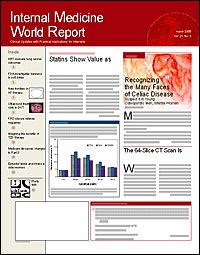Publication
Article
Internal Medicine World Report
High Estradiol Levels Increase Stroke Risk in Older Women
Author(s):
Kissimmee, Fla?In postmenopausal women, high levels of endogenous estradiol are associated with an increased risk of stroke, an increased risk that appears to be attenuated by raloxifene (Evista), said Jennifer S. Lee, MD, of the California Pacific Medical Research Institute and the University of California, San Francisco, at the American Stroke Association's International Stroke Con?ference 2006.
The findings are derived from the Multiple Outcomes of Raloxifene Eval?uation (MORE) study, in which the effects of raloxifene on bone mineral density and vertebral fracture were investigated in 7705 postmenopausal women over a 4-year period.
Determining the overall effect of estradiol on stroke risk has been difficult, said Dr Lee. Estradiol action is complex in the brain and vasculature. "It may have a pro?tective effect on the neurons, potentially have beneficial effects against atherosclerosis and lipids, with adverse effects on inflammation and thrombosis," she said.
In clinical trials, "both estrogen alone and in combination therapy have conferred about a 40% increased risk of stroke compared with placebo," she said. "A recent meta-analysis of 28 randomized trials showed a significant 29% in?creased risk of ische?mic stroke with hormone therapy, which typically in?creas?es serum estradiol levels well into the premeno?pausal range."
In addition, in the Women's Estro?gen for Stroke Trial, women with stroke or transient ischemic attack who were taking estrogen had a 3-fold higher risk of having a fatal stroke or more severe recurrent stroke injuries.
The aromatase inhibitors anastrozole (Arimidex) and exemestane (Aromasin), which lower estradiol levels to near undetectable levels, were associated with a lower stroke risk than tamoxifen (Nolvadex) in 2 large trials of women with estrogen receptor?positive breast cancer, "probably because aromatase inhibitors block the thrombotic effects of estrogen, unlike tamoxifen, which seems to have more thrombotic and inflammatory effects," she said.
The selective estrogen receptor modulators (SERMs) such as raloxifene behave differently than estrogen. SERMs have both proestrogenic and anti- estrogenic effects, depend???????ing on the tissue site, with a proestrogenic effect on bone and an antiestrogenic effect on the breast.
"All SERMs are not the same," she said. A meta-analysis of 9 breast cancer trials showed an 82% higher risk of ischemic stroke in ta?mox?ifen users than in placebo recipients, whereas in the overall MORE study population, raloxifene had no significant effect on stroke risk.
In MORE, participants were at least 2 years postmenopausal, were 80 years old, and had no stroke or venous thromboembolic disease in the previous 10 years. Baseline estradiol measurements were obtained in 7290 women. Among the 2447 taking placebo, 1227 (50%) had undetectable levels of estradiol. Of the remaining 1220 women, 50% had levels >=16 pmol/L.
The women with estradiol levels >=16 pmol/L, representing the highest quartile of estradiol levels, had a 2.5 times higher stroke risk than women with lower estradiol levels (P <.015).
Compared with placebo, raloxifene did not significantly affect the risk of stroke in women with lower estradiol levels. But in women with higher levels of estradiol, raloxifene, 60 or 120 mg/day, reduced the risk of stroke by 55%, which was of borderline significance (P = .11). (The conventional P value used to determine significance in tests of interaction is 10, she explained.)
The findings warrant further study before the measuring of estradiol levels in clinical practice can be recommended, said Dr Lee. "We need a sufficient ?sample size to look at this interaction and outcome," she said. "If confirmed, ?measuring endogenous estradiol levels is a simple blood draw and may help in assessing the risk of stroke in older women."






